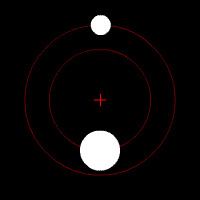(66063) 1998 RO1
|
Orbit of (66063) 1998 RO1 | |||||||||||||||||
| Discovery[1][2] | |||||||||||||||||
|---|---|---|---|---|---|---|---|---|---|---|---|---|---|---|---|---|---|
| Discovered by | LINEAR | ||||||||||||||||
| Discovery site | Socorro | ||||||||||||||||
| Discovery date | 14 September 1998 | ||||||||||||||||
| Designations | |||||||||||||||||
| 1999 SN5 | |||||||||||||||||
| Aten asteroid[1] | |||||||||||||||||
| Orbital characteristics[1] | |||||||||||||||||
| Epoch 13 January 2016 (JD 2457400.5) | |||||||||||||||||
| Uncertainty parameter 0 | |||||||||||||||||
| Observation arc | 5111 days (13.99 yr) | ||||||||||||||||
| Aphelion | 1.7045 AU (254.99 Gm) | ||||||||||||||||
| Perihelion | 0.27733 AU (41.488 Gm) | ||||||||||||||||
| 0.99092 AU (148.240 Gm) | |||||||||||||||||
| Eccentricity | 0.72013 | ||||||||||||||||
| 0.99 yr (360.3 d) | |||||||||||||||||
| 109.48° | |||||||||||||||||
| 0° 59m 57.048s / day | |||||||||||||||||
| Inclination | 22.680° | ||||||||||||||||
| 351.88° | |||||||||||||||||
| 151.13° | |||||||||||||||||
| Known satellites | 1 | ||||||||||||||||
| Earth MOID | 0.0917105 AU (13.71970 Gm) | ||||||||||||||||
| Jupiter MOID | 3.35468 AU (501.853 Gm) | ||||||||||||||||
| Physical characteristics | |||||||||||||||||
| Dimensions | 700 m (2,300 ft) (assumed)[3] | ||||||||||||||||
| Mass | 5.976×109 mt[4] | ||||||||||||||||
Mean density | 2.8±1.3 g/cm³[5] | ||||||||||||||||
Equatorial surface gravity | 0.0624 mm/s2[4] | ||||||||||||||||
Equatorial escape velocity | 0.0999 mm/s[4] | ||||||||||||||||
| 2.4924 h (0.10385 d) | |||||||||||||||||
Sidereal rotation period | 2.4924 hours[1] | ||||||||||||||||
| 0.2 (assumed)[2] | |||||||||||||||||
| |||||||||||||||||
| 18.1[1] | |||||||||||||||||
|
| |||||||||||||||||
(66063) 1998 RO1 is an Aten asteroid with a very eccentric orbit that was discovered September 14, 1998, by the LINEAR program.[1][2] It is known to have a moon, S/2001 (66063) 1.
Interaction with Earth
1998 RO1's orbit is very eccentric, with an aphelion beyond the orbit of Mars and a perihelion inside the orbit of Mercury.[2] It has an orbital period of 360.29 days (0.99 years) and makes close approaches to Earth.[1] But 1998 RO1 makes closer approaches to other inner planets, especially Mars. Its closest approach to a planet between 1950–2200 was to Mars, as it passed 0.00898 AU (1,343,000 km) from Mars on March 19, 1964, and will pass 0.0054 AU (810,000 km) from Mars on October 12, 2065.[1]
Moon

1998 RO1 has one moon, S/2001 (66063) 1.[2] This moon was discovered from lightcurve observations going from September 13–28, 2013, and was confirmed by radar observations from the Arecibo Observatory one year later.[2][6] It is in a very close orbit to 1998 RO1, with a semi-major axis of 800 m (2,600 ft) and an eccentricity of 0.06,[2][5] giving it a periapsis of 752 m (2,467 ft) and an apoapsis of 848 m (2,782 ft). S/2001 (66063) 1 takes 14.54 hours to complete one orbit around 1998 RO1.[5] From the surface of 1998 RO1, S/2001 (66063) 1 would have an apparent diameter of roughly 41°.[lower-alpha 1] For comparison, the Sun appears to be 0.5° from Earth.
Notes
- ↑ Calculated by solving .
References
- 1 2 3 4 5 6 7 8 "66063 (1998) RO1". JPL Small-Body Database. Jet Propulsion Laboratory. SPK-ID: 2066063. Retrieved 6 April 2016.
- 1 2 3 4 5 6 7 Johnston, Robert (March 29, 2009). "(66063) 1998 RO1". Johnston Archive. Retrieved 19 December 2013.
- ↑ Used absolute magnitude and albedo values for Bruton, Dan. "Conversion of Absolute Magnitude to Diameter for Minor Planets". Stephen F. Austin State University. Retrieved 23 December 2013.
- 1 2 3 4 Used mean density/albedo value for "Exoplanets Calculator". Planetary Habitability Laboratory. University of Puerto Rico. Retrieved 20 December 2013.
- 1 2 3 "Modeling of Lightcurves of Binary Asteroids". Icarus. 200 (2): 531–547. April 2009. Bibcode:2009Icar..200..531S. doi:10.1016/j.icarus.2008.12.001.
- ↑ Benner, Lance (November 28, 2013). "BINARY AND TERNARY NEAR-EARTH ASTEROIDS DETECTED BY RADAR". Jet Propulsion Laboratory. Retrieved 30 December 2013.
_1998_RO1.gif)